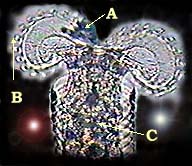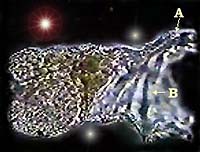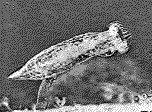Best viewed in Netscape 4 or
Explorer 4 in 800x600
| |
A
Micscape Magazine« Wonder article
by Ken Jones and
Maurice Smith 1997
JAWS |
|
If
I were a tiny creature, the size of a single celled amoeba - say,
one of the small limax types about 1/20 mm long - the beast above
would represent a creature the size of a whale 38 metres in
length on my human scale now. But where as the whale would glide
towards me in the sea, almost silently, the Rotifer above, would
appear and sound entirely different!
Its crowned cilia would seem to
spin like massive twin turbines - churning the water, droning and
roaring, growing ever louder as I am sucked by the water vortex
created, into a gaping mouth and pulped by steel-hard jaws
deep within the animal's interior.
Whereas a shark in the sea is an
absolute predator and perfect killing machine in my human world,
the rotifer represents the equivalent of 'Jaws' at a microscopic
level in our freshwater ponds.
And just as sharks come in all
shapes and sizes, so too do rotifers. Also known as wheel
animalcules, due to many types possessing a ciliated (cilia
are like fine hairs - B) region on
their head - which looks like a wheel organ and gives an illusion
of rotating wheels - rotifers exist in more than 1000 different
species. Most are freshwater animals ranging in size from 25Ám
to 2 mm in length but several species occur in the ocean.
 The one shown right is just in
the act of trying to 'suck-in' an even smaller life form, not
very clear here - A,
which will be instantly crushed by its jaw-like trophi - C, Most forms
possess a foot attached to the rear end of the body, and
terminating in two or more prehensile toes. The rotifer will use
this to fix itself temporarily to the substratum or pond
vegetation, often when feeding. Not all rotifers have the
wheel-like organ around their mouths.
The one shown right is just in
the act of trying to 'suck-in' an even smaller life form, not
very clear here - A,
which will be instantly crushed by its jaw-like trophi - C, Most forms
possess a foot attached to the rear end of the body, and
terminating in two or more prehensile toes. The rotifer will use
this to fix itself temporarily to the substratum or pond
vegetation, often when feeding. Not all rotifers have the
wheel-like organ around their mouths.
 For example, this one shown
right, has a completely different feeding mechanism: a massive
mouth opens - where the extreme points - A of the opening
are populated with bundles of long fine cilia, used to help 'net'
its prey, and funnel it into its interior - B.
Amateur
Microscopists delight in observing these tiny animals. In all
senses of the word, a rotifer is a true creature - some of them
even have the capacity to give birth to live young. All of the
different types exhibit behaviour fascinating to watch, and still
little is known about their life routines and progress.
For example, this one shown
right, has a completely different feeding mechanism: a massive
mouth opens - where the extreme points - A of the opening
are populated with bundles of long fine cilia, used to help 'net'
its prey, and funnel it into its interior - B.
Amateur
Microscopists delight in observing these tiny animals. In all
senses of the word, a rotifer is a true creature - some of them
even have the capacity to give birth to live young. All of the
different types exhibit behaviour fascinating to watch, and still
little is known about their life routines and progress.
Some
people (certainly not amateur microscopists) would wonder about
the significance of animals so small. Most people never get to
think or realize that if the rotifers died out as a life form, or
any of the other microscopical creatures, than it would have a
massive impact on both the planet and the larger life-forms
inhabiting it (us!).
There
is a link in all living forms... a balance which ensures the
number of predators remains at a certain level and the prey at a
different but equally consistent population. If something happens
to affect one living thing, it can have a knock-on consequence
which can ripple up the food chain, or even alter the entire
global ecology.
In
relative terms, Rotifers represent a higher life form than many
other microscopic pond dwellers. Some of them seem to be able to
detect their prey in the water either by physical movement or by
chemical signals. In many ways, they are a highly developed
animal - akin to the relative difference between a shark (or a
whale) and that of its food supply in a macro world.
Many
microscopists already explore the behaviour of rotifers but the
world could do with many others discovering and exploring
creatures like this to learn just how they contribute to the
survival of life in general. Many secrets await discovery, too
few people to date realize the importance of a world normally out
of sight and out of mind. For any budding amateur scientist, here
then is a creature which can be extracted from most local ponds,
brought home for study under a microscope, and many things learnt
which will have long-standing value and significance to the
knowledge of our world and our place within it.
Ken
Jones is an amateur microscopist living in the UK who has
realized this remarkable insight. His stunning videos and
dedicated work has captured these creatures on video film for all
to see. If you have never looked at one of these creatures
through a microscope, you will never realize how living animals
and their range of shapes and behaviours extend far beyond the
more-known and familiar world of creatures we encounter in our
everyday lives. The world grows smaller. Opportunity to be
stunned and exhilarated by fresh discoveries, and to obtain fresh
perspectives, dwindle as the world shrinks.
Amateur
Microscopy is not a pursuit for those who would prefer to close
their eyes and dream of perpetual holidays doing nothing
important. It is a pastime for all people who would consider the
mystery which still surrounds our existence, the Universe, and
the part that 'Life' has to play in its unknown development. For
those of you who would wish to see your life as an opportunity to
explore everything in it to the full, and to find a single aspect
to set your mind racing with ideas and help satisfy a yearning to
be part of significant exploration into the way life is
maintained and developed, microscopy is the window of opportunity
for you to accomplish your aim.
Take a look again at what a
rotifer is and ask yourself a single question: what is its
importance? View a low quality streaming video of
Ken's high quality Rotifers
Return
to Microscopy-UK Front Page
Return to Micscape Magazine Index
ALL MATERIAL (C) MICSCAPE
MAGAZINE OR ITS CONTRIBUTORS 1997 Video
sequences copyright Ken Jones 1995 - 1997 and used here by
permission.
WIDTH=1
© Onview.net Ltd, Microscopy-UK, and all contributors 1995 onwards. All rights
reserved. Main site is at www.microscopy-uk.org.uk with full mirror at www.microscopy-uk.net.
 The one shown right is just in
the act of trying to 'suck-in' an even smaller life form, not
very clear here - A,
which will be instantly crushed by its jaw-like trophi - C, Most forms
possess a foot attached to the rear end of the body, and
terminating in two or more prehensile toes. The rotifer will use
this to fix itself temporarily to the substratum or pond
vegetation, often when feeding. Not all rotifers have the
wheel-like organ around their mouths.
The one shown right is just in
the act of trying to 'suck-in' an even smaller life form, not
very clear here - A,
which will be instantly crushed by its jaw-like trophi - C, Most forms
possess a foot attached to the rear end of the body, and
terminating in two or more prehensile toes. The rotifer will use
this to fix itself temporarily to the substratum or pond
vegetation, often when feeding. Not all rotifers have the
wheel-like organ around their mouths.  For example, this one shown
right, has a completely different feeding mechanism: a massive
mouth opens - where the extreme points - A of the opening
are populated with bundles of long fine cilia, used to help 'net'
its prey, and funnel it into its interior - B.
Amateur
Microscopists delight in observing these tiny animals. In all
senses of the word, a rotifer is a true creature - some of them
even have the capacity to give birth to live young. All of the
different types exhibit behaviour fascinating to watch, and still
little is known about their life routines and progress.
For example, this one shown
right, has a completely different feeding mechanism: a massive
mouth opens - where the extreme points - A of the opening
are populated with bundles of long fine cilia, used to help 'net'
its prey, and funnel it into its interior - B.
Amateur
Microscopists delight in observing these tiny animals. In all
senses of the word, a rotifer is a true creature - some of them
even have the capacity to give birth to live young. All of the
different types exhibit behaviour fascinating to watch, and still
little is known about their life routines and progress.
